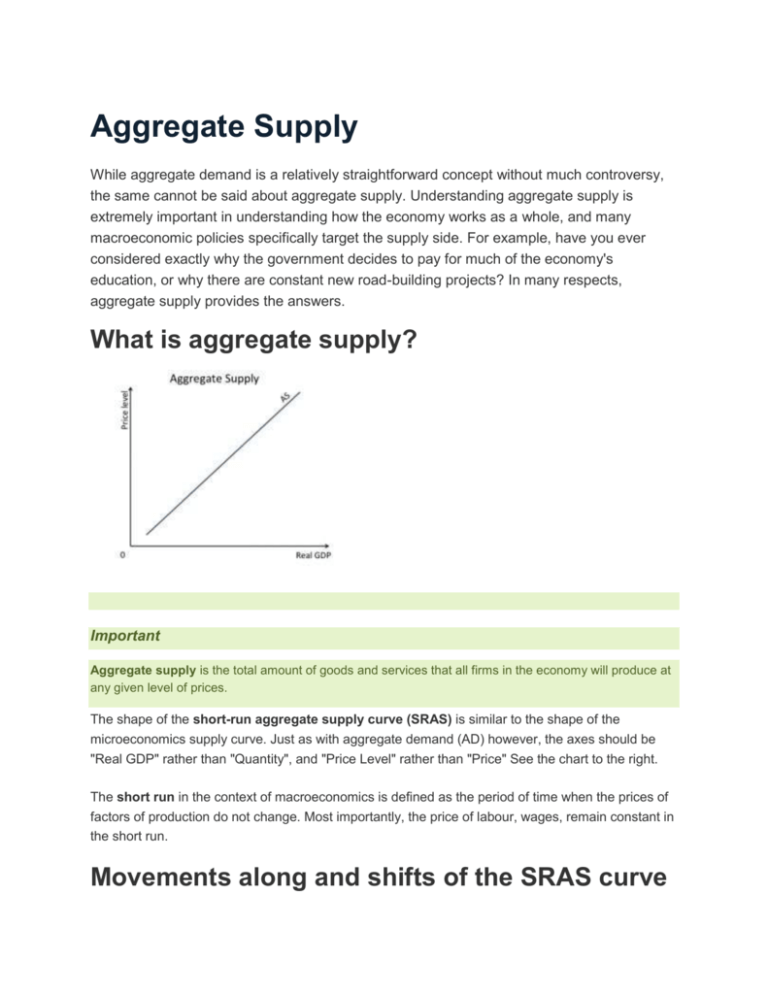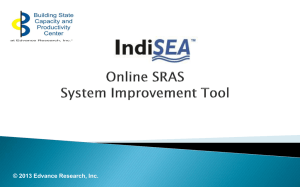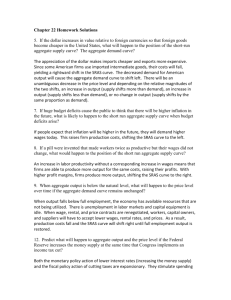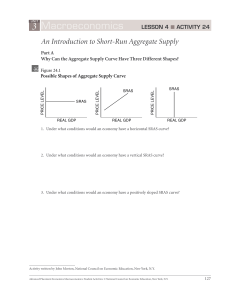Aggregate Supply
advertisement

Aggregate Supply While aggregate demand is a relatively straightforward concept without much controversy, the same cannot be said about aggregate supply. Understanding aggregate supply is extremely important in understanding how the economy works as a whole, and many macroeconomic policies specifically target the supply side. For example, have you ever considered exactly why the government decides to pay for much of the economy's education, or why there are constant new road-building projects? In many respects, aggregate supply provides the answers. What is aggregate supply? Important Aggregate supply is the total amount of goods and services that all firms in the economy will produce at any given level of prices. The shape of the short-run aggregate supply curve (SRAS) is similar to the shape of the microeconomics supply curve. Just as with aggregate demand (AD) however, the axes should be "Real GDP" rather than "Quantity", and "Price Level" rather than "Price" See the chart to the right. The short run in the context of macroeconomics is defined as the period of time when the prices of factors of production do not change. Most importantly, the price of labour, wages, remain constant in the short run. Movements along and shifts of the SRAS curve When there is a change in the level of prices, this will result in a movement along the SRAS curve either towards a higher Real GDP if the price level increases, or towards a lower Real GDP if the price level falls. This is because, ceteris paribus, firms receive more money for their products when the price level increases, and, as a result, they will produce more. A shift of the SRAS curve occurs when there is a change in any other factor affecting output, other than the price level. For example, if wages increase, there is a leftward shift in the SRAS curve as the costs of production increase. This is illustrated by the SRAS2 curve in the diagram to the right. On the other hand, if the government decides to lower company taxes, firms will be willing to produce more products and services as this has the same effect as a decrease in costs. In other words, there will be a rightward shift of the SRAS curve illustrated by the SRAS3 curve in the diagram. Supply shocks Supply shocks are events that have a major negative impact on the SRAS curve. For example, they can be the result of natural disasters, political controversy, market speculation etc. The situation is particularly serious if the supply shock occurs in relation to a product that is used by many industries as raw material in the production of other products. The most prominent example of such a product is probably oil. If oil prices increase, this will have a significant effect on the costs of producing a vast range of products and hence cause a leftward shift of the SRAS curve. AD and SRAS combined It is possible to plot the AD and the SRAS curves in the same diagram. The intersection of the curves marks the short run macroeconomic equilibrium. Just as in the case of the microeconomic short run, the equilibrium marks the point when there is no incentive for producers to increase their output, seeing that they would then produce more products and services than the population demands. The importance of the macroeconomic equilibrium will be more apparent when you start studying the concepts of inflation and unemployment and how these interact with AD and AS in both the short run and in the long run! What you should know Aggregate supply is the total amount of goods and services that all firms in the economy will produce at any given level of price. The short run is defined as the period of time when no prices of any factors of production change. A movement along the SRAS curve occurs when there is a change in the price level. A shift of the SRAS curve occurs when there is a change in any factor affecting production other than the price level, for example the number or quality of workers, the price of raw materials, etc. A supply shock occurs when the price of an important raw material, such as oil, increases. This causes a leftward shift of the SRAS curve.







